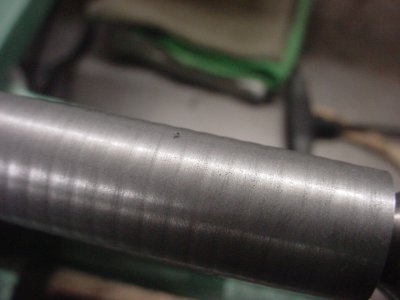- Joined
- Oct 17, 2018
- Messages
- 966
I was using the power feed on my Atlas/Craftsman 101.07403 lathe at its slowest setting to cut this steel rod to diameter. I was taking very light cuts: 0.005"-0.010". Spindle speed was about 266 RPM. I got a "scallop pattern as shown in the picture. The "scallops" shown vary in height about 0.001"-0.002" and are every 1/8" or so.

There is some play (maybe 0.005"; I need to measure it) on the cross feed; I think the screw (#10F-36) and/or the nut (#10F-19) are worn. Could the cross feed gibs not be tight enough? I had to hold the cross feed crank and watch the DRO to make sure the cutter didn't back out. I suspect one or both of these has something to do with it.
Any idea what could cause this?

There is some play (maybe 0.005"; I need to measure it) on the cross feed; I think the screw (#10F-36) and/or the nut (#10F-19) are worn. Could the cross feed gibs not be tight enough? I had to hold the cross feed crank and watch the DRO to make sure the cutter didn't back out. I suspect one or both of these has something to do with it.
Any idea what could cause this?
